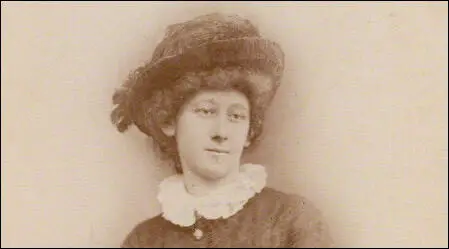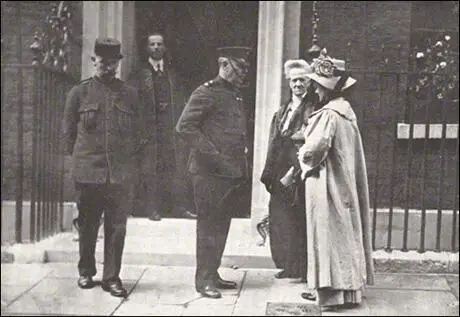Anne Cobden Sanderson

Anne Cobden, the fourth daughter of Richard Cobden, was born on 26 March 1853 at Westbourne Terrace, London. Her early years were spent at Dunford House, Midhurst, but after her father's death in 1865 she finished her education in Germany.
A supporter of women's rights she attended the Women's Suffrage Conference held in London in April 1871. Soon afterwards she joined the London Society for Women's Suffrage.
During this period she became friends with other suffragists such as Helen Taylor, Millicent Garrett, Elizabeth Garrett, Barbara Bodichon, Jessie Boucherett, Emily Davies, Francis Mary Buss, Dorothea Beale, Anne Clough, Elizabeth Wolstenholme-Elmy, Louisa Smith, Alice Westlake, Katherine Hare and Harriet Cook.
In 1874 with her sister Ellen she accompanied Sir Robert Lambert Playfair on his expedition to the Aures Mountains, Algeria. In 1877 she lived in London with her sisters and became involved in social work in the East End.

Anne Cobden married the barrister Thomas James Sanderson on 5th August 1882. They both held progressive political opinions and adopted the surname Cobden-Sanderson. Anne had two children, Richard (1884–1964) and Stella (1886–1979). She became good friends with William Morris and was influenced by the economic ideas of Henry George. Anne Cobden-Sanderson became a socialist and in 1890 joined Morris's Hammersmith Socialist Society. Anne and Thomas established the Doves Press and this became an important part of the Arts and Crafts Movement.
Anne eventually joined the Independent Labour Party and in 1902 organized a series of lectures for the ILP. She continued with her social work and supported Margaret MacMillan and Rachel MacMillan and their pioneering Bow Children's Clinic. The clinic provided dental help, surgical aid and lessons in breathing and posture. Anne and the MacMillan sisters also campaigned for school meals and compulsory medical inspection.
For several years Anne Cobden Sanderson was a member of the National Union of Women's Suffrage Societies. However, frustrated by its lack of success, she joined the Women Social & Political Union in 1905. She was the first prominent constitutional suffragist to defect to the militants. In October 1906 Anne, along with members of the WSPU, Mary Gawthorpe, Charlotte Despard and Emmeline Pankhurst, was arrested in a large demonstration outside the House of Commons. Her friend, George Bernard Shaw wrote in The Times, that "one of nicest women in England suffering from the coarsest indignity" of being in Holloway Prison.
In court Anne said: "We have talked so much for the Cause now let us suffer for it... I am a law breaker because I want to be a law maker." She was sentenced to two months' imprisonment. Millicent Fawcett wrote to The Times on 27th October 1906 to complain about the press reports of her behaviour in court: "I have known Mrs Cobden Sanderson for 30 years. I was not in the police-court on Wednesday when she was before the magistrate, but I find it absolutely impossible to believe that she bit, or scratched, or screamed, or behaved otherwise than like the refined lady she is." After Sanderson's release the NUWSS organized a banquet at the Savoy Hotel on 11th December. Those who attended included Beatrice Harraden, Minnie Baldock and Annie Kenney at the banquet.
In 1907 some leading members of the WSPU began to question the leadership of Emmeline Pankhurst and Christabel Pankhurst. These women objected to the way that the Pankhursts were making decisions without consulting members. Teresa Billington-Greig pointed out the absurdity of women fighting for votes in an organisation that refused them a voice in their own campaign. In the autumn of 1907, Anne Cobden Sanderson, Teresa Billington-Greig, Elizabeth How-Martyn, Dora Marsden, Helena Normanton, Anne Cobden Sanderson, Margaret Nevinson and Charlotte Despard and seventy other members of the WSPU left to form the Women's Freedom League (WFL).
According to Elizabeth Crawford, the author of The Suffragette Movement (1999): "Anne Cobden Sanderson proved one of the WFL's most tireless campaigners, speaking at outdoor meetings and continuing to take part in militant protests." She was arrested on 19th August 1909 while picketing the door of 10 Downing Street in order to present a petition to Herbert Asquith.

In October 1909 Anne Cobden Sanderson helped establish the Tax Resistance League (TRL). Founder members of the organisation included Louisa Garrett Anderson, Margaret Nevinson, Cicely Hamilton, Edith How-Martyn, Sime Seruya, Maud Arncliffe Sennett, Lena Ashwell, Dora Montefiore, Beatrice Harraden, Evelyn Sharp and Eveline Haverfield. The TRL remained under the auspices of the Women's Freedom League. The motto adopted by the TRL was "No Vote No Tax".
At its annual party conference in January 1912, the Labour Party passed a resolution committing itself to supporting women's suffrage. This was reflected in the fact that all Labour MPs voted for the measure at a debate in the House of Commons on 28th March. Soon afterwards Henry N. Brailsford and Kathleen Courtney, entered negotiations with the Labour Party as representatives of NUWSS.
In April 1912, the National Union of Women's Suffrage Societies announced that it intended to support Labour Party candidates in parliamentary by-elections.The NUWSS established an Election Fighting Fund (EFF) to support these Labour candidates. Anne Cobden Sanderson, who had been a long-time supporter of the Labour Party, contributed generously to the EEF.
In July 1914 the NUWSS argued that Asquith's government should do everything possible to avoid a European war. Two days after the British government declared war on Germany on 4th August 1914, Millicent Fawcett declared that it was suspending all political activity until the conflict was over. Although the NUWSS supported the war effort, it did not follow the WSPU strategy of becoming involved in persuading young men to join the armed forces.
Despite pressure from members of the NUWSS, Fawcett refused to argue against the First World War. Her biographer, Ray Strachey, argued: "She stood like a rock in their path, opposing herself with all the great weight of her personal popularity and prestige to their use of the machinery and name of the union." At a Council meeting of the National Union of Women's Suffrage Societies held in February 1915, Fawcett attacked the peace efforts of people like Mary Sheepshanks. Fawcett argued that until the German armies had been driven out of France and Belgium: "I believe it is akin to treason to talk of peace." Anne Cobden Sanderson was a pacifist and was once again in opposition to Fawcett.
In January 1915 Mary Sheepshanks published an open Christmas letter to the women of Germany and Austria, signed by 100 British women pacifists. The signatories included Anne Cobden Sanderson, Emily Hobhouse, Margaret Bondfield, Maude Royden, Sylvia Pankhurst, Eva Gore-Booth, Margaret Llewelyn Davies and Marion Phillips. It included the following: "Do not let us forget our very anguish unites us, that we are passing together through the same experiences of pain and grief. We pray you to believe that come what may we hold to our faith in peace and goodwill between nations."
After the war Anne Cobden Sanderson remained active in the Labour Party in Hammersmith. Her husband, Thomas James Sanderson, died in 1922. As her biographer, A. C. Howe, pointed out: "Following Thomas's death in 1922, Annie settled at great personal cost a lawsuit brought against her by Sir Emery Walker, seeking compensation for the typeface her husband had thrown into the Thames on closing the Doves Press in 1917."
Anne Cobden Sanderson died at 15 Upper Mall, Hammersmith, on 2nd November 1926.

